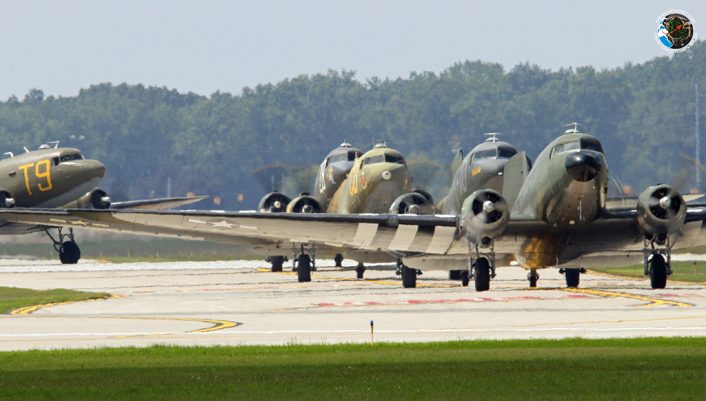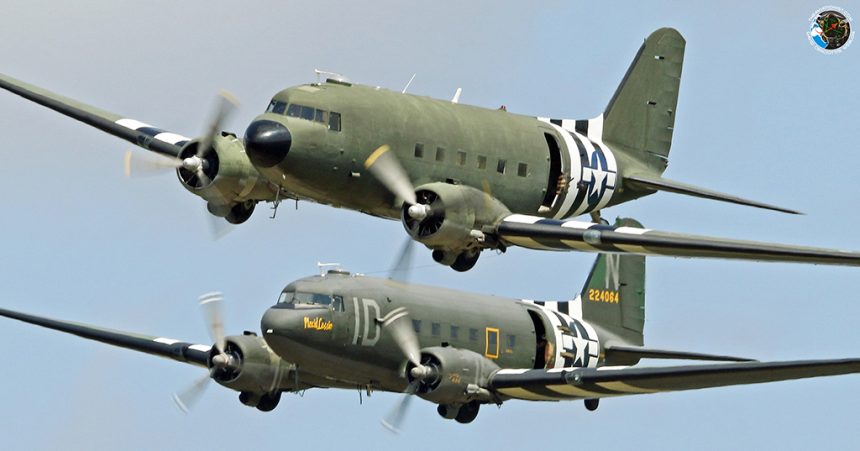Airlifter, Gunship, Spy Plane, VIP Transport and More: It’s Important to Understand the C-47.
It is a bit bumpy despite calm weather. She skids back and forth on her tail in light crosswinds and level flight. The crew in front of me is waltzing the big rudder pedals in the rising morning warmth. But when they heel over the big, round control yoke she listens with attentiveness. She likes the gathering G’s of increasing bank angle. The flight smoothes out as she enters the turn.
I am over half century old, and this airplane is a quarter century older than me, but there is safe comfort in flying on her. Propellers, airfoils, rivets and aluminum. It’s basic, dependable stuff. I understand her cockpit, her controls, her instruments. I could fly her, no problem. She is an obedient beast of burden with elegant swept wings and tame characteristics contrasting a strong back for carrying heavy loads. She is like a beet farmer’s golden-haired daughter dressed in silver coveralls.
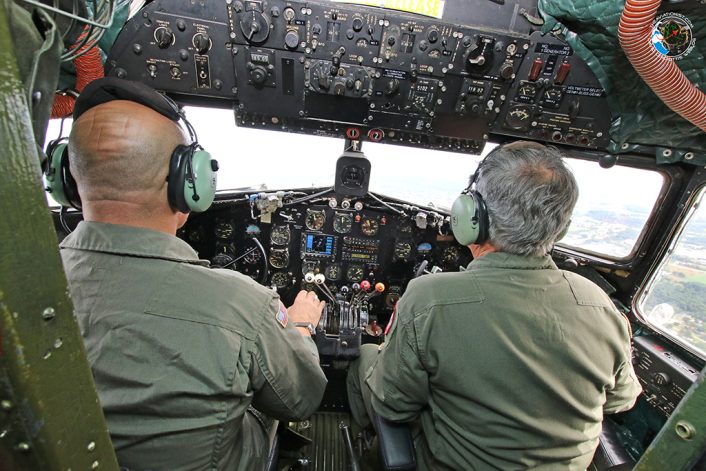
Our white and silver C-47 Dakota chortles through the sky with a deep, throaty hum accompanied by a chorus of little vibrations quietly rattling through her three-quarter century old airframe. But she is safe, sturdy and strong. Her eagerness to drift through the sky belies her age. Her thick airfoils love the wind and grip the sky like reigns.
WWII Supreme Allied Commander General Dwight D. Eisenhower said, “Most vital to our success in Africa and Europe has been the jeep, the 2½-ton truck and the C-47 Dakota.”
The Douglas C-47 Dakota is perhaps the most mundane, least exciting but quietly elegant and ruggedly stalwart aircraft of the last century. Simple and utilitarian, the aircraft was quickly designed in 1935, even more quickly manufactured in numbers exceeding 10,000 planes across a staggering 72 different versions. She flew roles as varied as attack aircraft, electronic warfare, intelligence gathering, transport, VIP flight and nearly every other mission an airplane can perform short of breaking the sound barrier.
We’re in a Douglas C-47 Dakota built in 1945, owned first by the U.S. Army, and later by the University of Michigan. Today she flies from Willow Run Airport in Ypsilanti as a living artifact of the Yankee Air Museum.
Most of the C-47’s that flew in WWII wore a flat olive drab cloak of paint hastily applied at an assembly plant that churned out Dakotas as quickly as they could. They were airborne pick-up trucks. In late May and early June of 1944 almost all of them in Europe sprouted wide, garish black and white stripes on their wings and fuselage; invasion stripes in anticipation of D-Day. But today our ride gleams, resplendent in white paint applied over natural aluminum rubbed to a high polish by the reverent men who love, maintain and fly her.
Capt. Dave Saunders is our flight engineer for this flight in the C-47 Dakota. He owns a staggering 25,000 hours of flying time. That is nearly three years of continuous time in a cockpit. Capt. Saunders has flown the Boeing 727, 737, 757, 767 and, for the last decade, the giant Boeing 777.
“We purchased her in 1982. Eighteen months to two years to recondition her to the condition she is in today.”
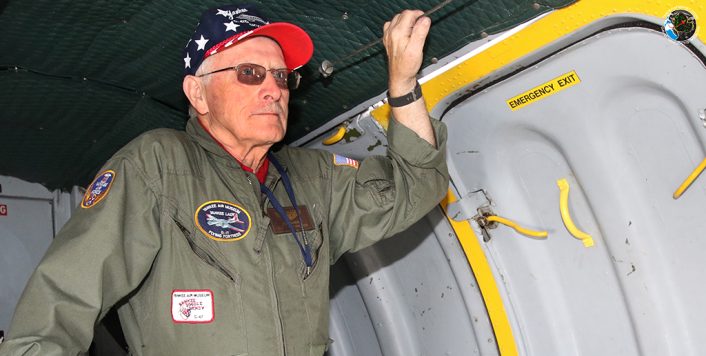
Capt. Saunders started flying when he was only 10 years old. His dad flew back and forth to work. He was hooked. Today Saunders is as much of a classic in the sky as the C-47 we’re riding in, so the two are a perfect match. As we hum along over the University of Michigan stadium in Ann Arbor, Michigan the other reporters on their aircraft type on their smartphones. Capt. Dave Saunders looks straight ahead, simply contemplating the way true flying was meant to be.
Our media flight takes us in a wide arc to the north and west of Willow Run Airport. Climbing out we look back toward the runway and see the Blue Angels lined up on the tarmac below. A giant Airbus Defense A400M Atlas, the most recent heir to the throne of the C-47 as the consummate transport, sits on static display.
The new Airbus A400M Atlas and the C-47 Dakota probably have more in common than they do apart. Both are considered medium to heavy airlifters. Both use propellers, there was no choice when the C-47 was designed, the A400M could have been a jet, but advantages of modern turboprops including fuel economy and simplicity nodded back toward the propulsion family of the C-47 on the new Atlas. Finally, both aircraft are incredibly significant to the militaries that operate them. In an irony of history, the C-47 played a massive role in the post WWII Berlin Air Lift along with the newer C-54. The largest operator of the new Airbus Defense A400M is Germany.
When I try to make an analogy between the C-47 Dakota we are flying in and an aircraft of today, the Boeing 737, Capt. Dave Saunders corrects me.
“The C-47 is more like the Boeing 727 of today.” Saunders shows his age and obvious reverence for the prolific three-engine airliner that was last flown in U.S. passenger service in early 2002 by American Airlines. But the Boeing 727 was never used in the regular military transport role. The venerable Boeing 737 airframe is a twin-engine aircraft that is used by several militaries, including by Australia in the surveillance, anti-submarine and mid-air refueling role and by the U.S. Navy in the same capacities.
I’m in the cockpit now. Capt. Tony Budacavolli and First Officer on this flight Vaughn Bateman are flying. There are only round instruments here. No retrofitting to touch screens, no side sticks, no flight computers except Capt. Budacavolli’s iPhone, an app-driven flight instrument he shares with many Russian pilots.
“It’s a blessing and a wonderful thing.” Capt. Buttacavolli tells us. Buttacavolli started flying DC-3’s as a commercial pilot, unusual for a modern pilot but testament to the staying power of the venerable Douglas airframe across all its versions civilian and military. “I started flying these for cargo back in the late 1980’s. I caught the last wave of them.”
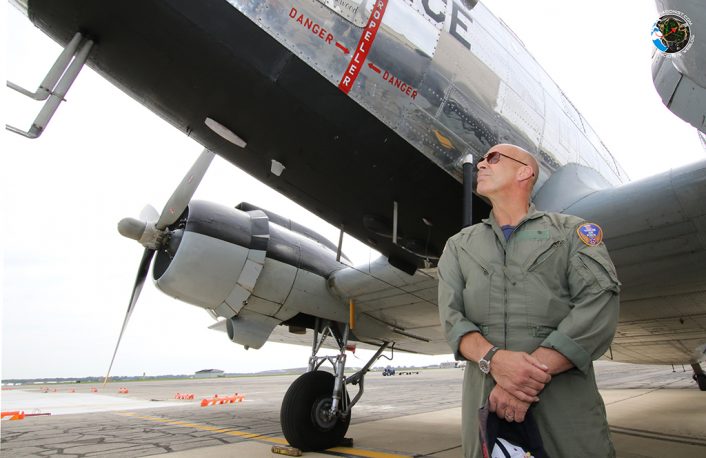
Capt. Vaughn Bateman flew Boeing 747’s before retiring from the airlines and the Navy where he flew the P-3 Orion anti-submarine warfare and maritime surveillance aircraft. Bateman sits right seat in our C-47 today. The cockpit is his home and after flying “nearly everything” he seems to take a comfortable solice among the simple, basic flight controls of the C-47.
Our wide arc through the southeastern Michigan sky brings us back toward Willow Run airport and runway 23-Lima, “23L” or two-three left. It’s a bit bumpy on approach through rising air. Thunderstorms are in the forecast for latter.
I expect the landing may be a bit bouncy on two wheels before the tailwheel sets down on the runway, but I underestimate the design of the C-47’s elegant wings and the skill of thousands of hours in our cockpit. Our two main wheels touch the runway with barely a nudge and we hardly sense the tailwheel settling. I somehow thought, because this is an old airplane, it would be somehow rougher. I’ve flown in a lot of older prop planes from B-17s to C-7s and C-130s. None of them were as smooth and elegant as this C-47.
Back on the ground a group of men just barely older than our aircraft stroll out of the Yankee Air Museum’s hanger to wipe the C-47’s landing gear struts down after her landing. She is massaged like an aging boxer who just sat on a stool in the corner of the ring, yearning to get back up for one more round.
